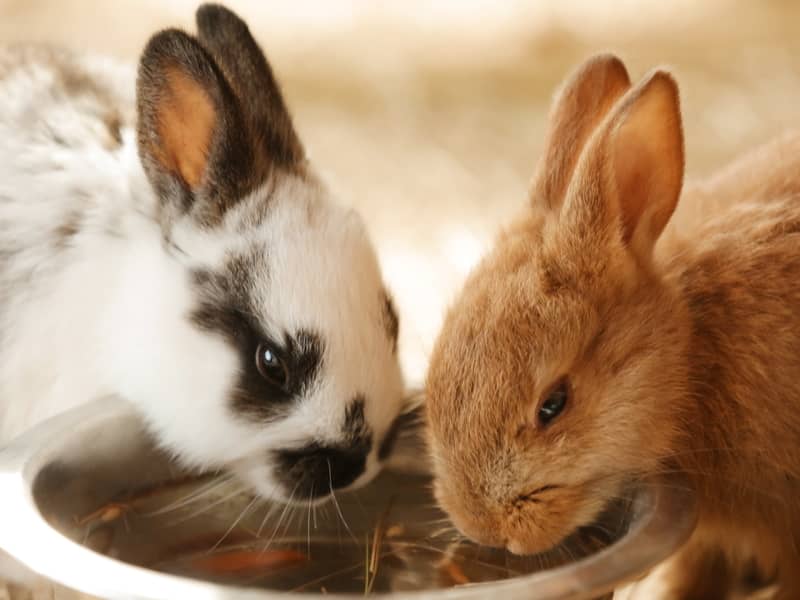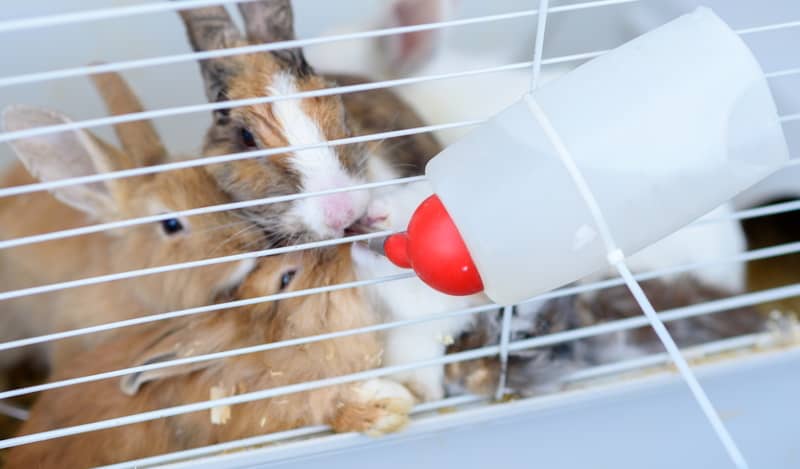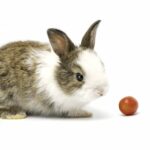Do you want to know whether a water bowl or a bottled water feeder would be better for your rabbits? The water bowl vs. bottle feeder dispute is a hotly contested topic.
If you’re no stranger to caring for rabbits, you’ve probably encountered both of these methods. But which one is the superior option?
Over the course of many years as a rabbit owner, I’ve experimented with both approaches and picked up a wealth of knowledge on each.
In this piece, we’ll discuss the pros and cons of using a water bottle vs a bowl to hydrate your rabbits.
If you want to know how to properly hydrate your rabbit, read on!
Why do Rabbits need to drink enough water?
As a general rule, a rabbit can consume up to 150 ml per 2.2 pounds (1 kg) of body weight per day.
According to that formula, larger breeds like the French Lop or Flemish Giant will require significantly more water than smaller types like the Netherland Dwarf or Mini Lop.
Because of this, you’ll want to provide them with water in a bottle or bowl that’s proportional to how much they’ll need to drink.
In order to keep your pet rabbit healthy, you must provide it with fresh water at all times.
Water not only helps keep you hydrated, but it also helps keep your digestive system and other organs like your liver, kidneys, and bladder running smoothly.
Under stress, rabbits are especially susceptible to dehydration.
Therefore, it is crucial that your rabbit always has access to clean water, regardless of the watering system you use.
Using a Water Bottle for Your Rabbits
While filling a bottle is generally easier and cleaner than filling a water bowl, both have their drawbacks.
The use of a bottled water feeder for your rabbits has both benefits and drawbacks, which we will discuss below.
Pros
As was previously noted, bottle feeders require much less upkeep than water bowls. It’s less of a hassle to keep them clean, and if water becomes dirty, it won’t ruin as much food.
You can save money, time, and hassle by providing your rabbits with bottled water, as described here.
- Bottles are cleaner: Rabbits can make a lot with mess water bowls, whether it’s tipping them over or messing up their bedding. So, having a bottled water feeder for your rabbits is much cleaner than a water bowl. You won’t have to wash them out as often as in a water bowl, but it should still be done at least once a week.
- There’s less waste: There’s less water waste when you use a bottle as opposed to a water bottle. This is because your rabbit can’t tip it over, and even if they come off, it won’t spill everywhere. Your rabbits can’t dump the bottle or get the water inside dirty, so it doesn’t need to be cleaned as often either.
Cons
As clean and low-maintenance as bottled water feeders are, they do have cons as well. Let’s look at some of the downsides of opting for a bottle feeder for your pet rabbits.
- It’s awkward for rabbits to use: Drinking from a bottle isn’t natural for rabbits. Having their head and neck tilted upward is really awkward positioning that can cause damage in later years, especially because they have to drink for longer. This is especially if you don’t put it at the right height. If it’s high enough to keep their neck straight, then it’s better.
- Less water distribution: Bottled water feeders only let your bunny drink one drop of water at a time, which can become tedious, even for a thirsty rabbit. This also means that your bunny spends longer trying to drink an adequate amount of water with its head in an awkward position.
- Bottles can get clogged: Another downside to giving your rabbits water from a bottle feeder is that the ball can get stuck, and the spout can get clogged easily. Rabbits that go back and forth while eating and drinking can cause a buildup of kibble residue that can cause the ball to get stuck or for the spout to clog. It can also happen if the spout isn’t cleaned properly.
Using a Water Bowl for Your Rabbits

When keeping multiple rabbits as pets, it’s best to provide them with their own individual water dishes.
Yet, because they are so simple to overturn, water bowls require regular attention from the caretaker. Let’s delve more into the pros and cons of using water dishes.
Pros
Water bowls tend to be the favorites of the two options. It’s said that most rabbits actually prefer the water bowl over the bottle. Here are some pros to having a water bowl for your bunnies.
- Easier to drink from: Earlier, we talked about the awkward head positioning that a bottle feeder can cause. Water dishes and bowls are much easier for a rabbit to drink out of. Not to mention they can drink water freely, instead of one drop at a time.
- Water is fresher: Water dishes usually need to be filled up or washed out more often than bottle feeders. And, while this may seem annoying, it does mean that because the water is constantly being refilled and rabbits drink more from a bowl at a given time, the water is typically fresher.
Cons
Even if a water bowl is easy on your bunny, it has its downfalls like having to be cleaned way more often, especially if you’re rabbits are particularly rambunctious and tip their bowls.
Let’s talk about the cons of using a water bowl for your rabbits instead of a bottle feeder.
- Need to be cleaned and refilled more often: One of the downsides to having a water bowl for your rabbits is the fact that you’ll need to fill and clean it more often. Not only because they may get tipped or get dirty, but also because your rabbit will drink more.
- Easy to dump or get messy: Unless you get really heavy stone water bowls, they’re really easy to tip over, which will leave your rabbit without water until you notice the dumped dish. If your rabbits make a habit out of it, it can add up quite a bit of water and bedding waste. Also, when rabbits drink their backwash will leave a film in the bowl that will need to be washed daily.
Water bowls are unsanitary for rabbits

The water bowl for your rabbit can still become polluted if you don’t keep it far from the rabbit’s food, litter, and hay.
There is a high risk of contamination from sneezes and coughs in the same room as the water bottle.
Human-animal transmission of viruses and bacteria is rather rare, although it does occur. Covid-19 has recently spread from animals to humans.
Your rabbit’s water bowl is susceptible to contamination from things like coughing and sneezing as well as hair, dust, cleaning agents, hair, dead skin cells, pollen, mites, bugs, dung, and urine.
It’s possible that your rabbit won’t have any health problems as a result of this, but is it really worth taking the chance?
Water bottles are better than bowls
Mr. Bunny and my other rabbit pets have always benefited from drinking from water bottles, but bowls will do in a pinch.
- Cleanliness – Covered in the paragraph above already.
- Water tracking – Most water bottles come with measurements along the side so if you do want to be able to track how much water your rabbit is drinking then a water bottle is key.
- Convenience – You can get some pretty big water bottles so you don’t have to fill them up as often. Water dishes can only be so big that your rabbit is not afraid of them. They do not like water so if you have some giant bowl they will be uneasy about using it and you never want to deprive your rabbit of water. Therefore you need to fill up the smaller dish much more often than you would the water bottle.
Using a water bottle is simply my suggestion from personal experience and does not obligate you to do so.
Many people who keep rabbits as pets use water bowls, and the animals drink from them just fine.
For the reasons we’ve stated, we’ve come to the conclusion that using a water bottle is your best and most efficient option.
Conclusion
Although bottle feeding is more convenient for human pet owners, it isn’t ideal for rabbits.
It has been found that when given the option between a water bowl and a bottled water feeder, rabbits choose the bowl.
We all know that bunnies aren’t created equal. It’s possible that habituated rabbits won’t ever change their minds about the bottled water feeder. I make use of both approaches.
Chile, my younger rabbit, often knocks over his water bottle as well as his food bowl. My senior bunny, on the other hand, is a bowl guy.
Even if they haven’t encountered one of the choices previously, I think it’s important to give them both to work with at first.
If your rabbit is a bowl tipper, this will ensure they have access to water. In time, you’ll figure out their preferred method and cater to it.
You can’t go wrong if you’re always meeting your rabbit’s requirements.






